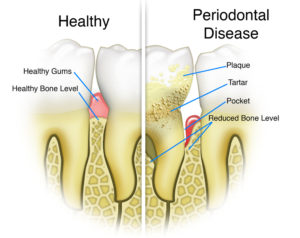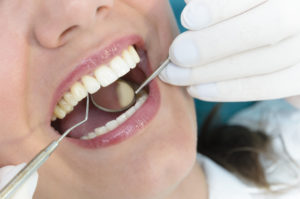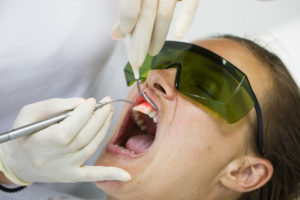How to Treat Infected Gums
Gum disease affects an estimated 30% of American adults. When left untreated, it can lead to the loss of teeth. There is a variety of ways to treat gum disease, and one of the most advanced and successful treatments involves using a laser. At Designer Smiles, we are committed to providing excellent dental care using the latest technology.
What causes Gum Disease?
 Gum disease (also referred to as periodontal disease) is the result of a bacterial infection between the teeth and gums. The bacteria present in dental plaque produce toxins, so when plaque is not removed from the teeth, these toxins cause the body to respond with inflammation.
Gum disease (also referred to as periodontal disease) is the result of a bacterial infection between the teeth and gums. The bacteria present in dental plaque produce toxins, so when plaque is not removed from the teeth, these toxins cause the body to respond with inflammation.
In its acute form, inflammation causes redness, swelling, tenderness and bleeding in the gums. You probably know this as gingivitis. If acute inflammation is not addressed, it becomes chronic, and chronic inflammation is bad news. Chronic inflammation causes the destruction of the bone surrounding a tooth’s roots. This is periodontal disease. It is a loss of the attachment between the teeth and the supporting jawbone.
What are Pockets?
Pockets are the result of periodontal disease, when the bone detaches from the tooth’s root due to chronic inflammation and bacterial buildup. We determine the presence of pockets when we measure the gums. You may hear us calling this an “FMP”, which means full mouth periodontal evaluation. Your dental hygienist or dentist uses a teeny tiny “ruler” marked in millimeters to measure the gaps between the teeth and gums.
Healthy gums have only a 2-3 millimeter crevice where they meet the teeth. In cases of periodontal disease, pockets can be early stage at levels of 4-5 millimeters or late stage, extending down the entire length of the tooth’s root.
 If you listen to the numbers called out during an FMP, the higher the number, the worse the periodontal disease is.
If you listen to the numbers called out during an FMP, the higher the number, the worse the periodontal disease is.
Periodontal disease can affect a single area on one tooth (localized), or it can surround every tooth in the mouth (generalized). As with every disease that affects the human body, when you catch periodontal disease early, it is much simpler and less expensive to treat. Treatments are also more successful the earlier you complete them.
How does Designer Smiles Treat Infected Gums?
We mentioned in the previous section that untreated acute inflammation proceeds to chronic inflammation in the periodontal disease process. Our goal is to intercept inflammation as early as possible. In many cases, though, we do not see patients until their periodontal disease has progressed past the acute inflammation stage.
When pockets deeper than 4 millimeters are present, your toothbrush and floss are no longer capable of removing plaque buildup at the depth of the pocket. This is why dental treatment is necessary.
In order to treat infected gums, you must go back to the initial cause of the disease: the bacteria. You may have heard the term “deep cleaning”, which refers to the professional treatment that removes all of the bacterial buildup from the pockets.
At Designer Smiles, we take “deep cleanings” up a notch. Rather than simply mechanically cleaning out plaque and tartar buildup from pockets and hoping that the body responds well, we add the use of a dental laser.
How Does a Laser Treat Infected Gums?
Dental lasers improve the success of pocket treatments in two important ways. First, laser energy is lethal to bacteria. When we use a laser within a deep pocket, it effectively “sterilizes” that haven for disease-causing bacteria by killing them all. This helps your body begin to heal from a clean slate. It removes the potential of any further toxin production, and allows the body to stop the inflammatory process.
In addition, laser energy also fights inflammation in the tissues. It helps to turn off the inflammatory process that is causing destruction of the jawbone.
By targeting both the cause of the gum disease and the body’s response, lasers make gum disease treatments more effective.
FAQs about Laser Pocket Treatment
To dental professionals, the use of lasers is common and familiar. However, we know that to a patient, this may be something new, and with the unfamiliar come questions.
Does Laser Treatment Hurt?
 No.
No.
During the procedure, you will most likely have local anesthesia to prevent you from feeling anything uncomfortable. After the numbness wears off, you may notice some mild tenderness in the treatment site. Because of its effects on inflammation, most laser treatments do not cause any significant post-operative pain.
What is the Recovery Process from Laser Treatment?
Quite simple!
Your dentist will give you any specific instructions, but in general, you will need to keep the area as clean as possible with great oral hygiene. This does NOT mean vigorous brushing or flossing. Your dental hygienist or dentist has removed the plaque and tartar buildup. There is no need for anything aggressive at this point. Gentle brushing and flossing will remove any daily buildup as the gums heal.
You should only have mild tenderness in the treatment site for the first few days. If you experience any lingering or severe pain, let us know as soon as possible.
How Do I Know if It Worked?
Your dentist will schedule a follow-up appointment, typically within about six weeks, to evaluate the treatment site. This may involve re-measuring the pocket depths at this time. The healing process is relatively delicate, and you can actually cause damage if you measure the pockets too soon after treatment.
Your chances of success are very good if you follow all of the post-operative instructions Dr. Ann and Dr. Lauren give you!
More Questions about Laser Gum Disease Treatments?
If you or a loved one has gum disease, call Designer Smiles today to schedule a consultation with Dr. Ann and Dr. Lauren. They can assess your specific situation and discuss the treatment options that will give you the best chance at keeping all of your teeth as long as possible.
